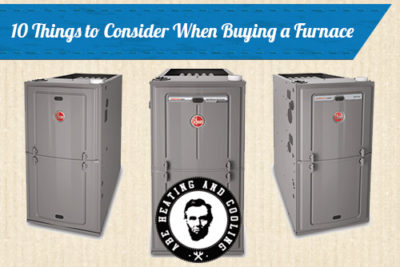“Abe's Heating and cooling were professional and on time. they helped me with two time sensitive projects and did excellent work. I know who I'll be calling if I should ever need an HVAC technician.”
Blog
 “Yay! We need a new furnace!” said (probably) no one ever. Unless you’ve been waiting patiently for your old, inefficient furnace to take its last breath so that you can finally upgrade to a new one, the thought of a major purchase like this will not likely fill you with joy. But don’t worry. We can help you navigate the options.
“Yay! We need a new furnace!” said (probably) no one ever. Unless you’ve been waiting patiently for your old, inefficient furnace to take its last breath so that you can finally upgrade to a new one, the thought of a major purchase like this will not likely fill you with joy. But don’t worry. We can help you navigate the options.
Here are 10 things to keep in mind when shopping for a new furnace:
Be sure to weigh the increased upfront cost for a higher efficiency furnace against the increased energy savings you will enjoy over the life of the unit.
Your new furnace will be vastly more efficient than your old one, simply because technology has advanced significantly over the past few decades. There is, however, a broad range from the minimum-efficiency required to meet regulations and the top-of-the-line models. Greater efficiency translates into less wasted energy, better performance and lower operating costs.
Efficiency is measured in AFUE (annual fuel utilization efficiency) — the higher the AFUE rating, the greater the efficiency. The minimum acceptable AFUE in Colorado (and many other states) is 80%. Because our winters can be quite cold, however, a higher AFUE furnace will be worth the added expense because lower energy bills will help you quickly recoup the extra cost, and will continue over the life of the unit.
Add an efficiency boost to your furnace by reducing the amount of work it does throughout the day. Programming your system allows you to effortlessly lower the temperature at night (the Sleep Foundation recommends temperatures between 60-67 degrees Fahrenheit for optimal sleep), and during the day when no one is home. For each degree you lower your thermostat during an 8-hour period, you can reduce your heating bill by about 2 percent.
Getting the correct size furnace for your home is the most important consideration. When it comes to comfort, a bigger furnace is not always better. When it comes to cost, a smaller furnace isn’t always more economical. Furnace size is measured in BTUs. Installing one that is too big will cause the unit to cycle more frequently, essentially making it work harder than necessary. This increases operating costs, puts you at risk for more frequent repairs, and can shorten the life of your furnace. A furnace that is too small will simply be unable to fully heat your home and will run all the time, running up your energy bills. Having a licensed contractor determine the correct size for your home should be one of the first steps in choosing a furnace.
Three options account for varying degrees of comfort and efficiency.
The type of blower (the part that actually blows the air into your rooms) also affects comfort and efficiency.
Zoning is another way to improve the efficiency and comfort provided by your furnace, while reducing energy costs. By using multiple thermostats, you can control the temperature in different areas of your home independently of one another. Typically, two or three zones are created. Zoning by floor or separating living areas from sleeping areas are two examples. In this way, you aren’t paying to heat areas of your home when they aren’t being used, or you have the flexibility to allow for different comfort levels depending on how those areas are used. For example, you may prefer cooler temperatures in the bedrooms and warmer temperatures in the living areas.
Warranties vary by manufacturer and the HVAC company and/or installer, so make sure you are comparing apples to apples. In other words, be sure the warranties you are comparing are for comparable furnaces. More efficient (and expensive) furnaces tend to have longer warranties than basic models. Look for a long-term warranty on the heat exchanger.
If the warranty on the furnace you purchase does not include labor, ask about an additional warranty from your contractor.
Many high-efficiency furnaces qualify for rebates or other incentives from local utility companies. This means money in your pocket that can make a pricier furnace more affordable. Ask your HVAC professional what rebates and incentives are available.
Don’t make your decision based solely on price. An overpriced system and a system that is cheap can each be a poor fit for your home. Consider your needs, your budget, the purchase price and the costs over the life of your furnace when making your decision.
Don’t skimp on quality installation. Proper installation is a key component of the overall performance of your furnace, the efficiency of the system, and the life expectancy of the equipment.